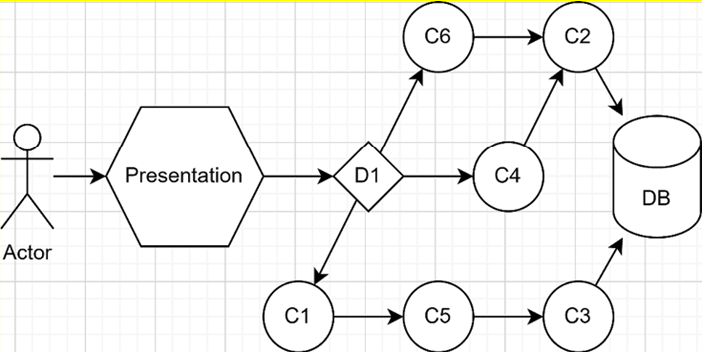Next is a dependency map of a hypothetical system. We use that diagram to pick the most meaningful type of test possible for each piece of the program. In real life, that diagram will most likely be in your head, but I drew it out in this case. Let’s inspect that diagram before I explain its content:

Figure 2.2: Dependency map of a hypothetical system
In the diagram, the Actor can be anything from a user to another system. Presentation is the piece of the system that the Actor interacts with and forwards the request to the system itself (this could be a user interface). D1 is a component that has to decide what to do next based on the user input. C1 to C6 are other components of the system (could be classes, for example). DB is a database.D1 must choose between three code paths: interact with the components C1, C4, or C6. This type of logic is usually a good subject for unit tests, ensuring the algorithm yields the correct result based on the input parameter. Why pick a unit test? We can quickly test multiple scenarios, edge cases, out-of-bound data cases, and more. We usually mock the dependencies away in this type of test and assert that the subject under test made the expected call on the desired component.Then, if we look at the other code paths, we could write one or more integration tests for component C1, testing the whole chain in one go (C1, C5, and C3) instead of writing multiple mock-heavy unit tests for each component. If there is any logic that we need to test in components C1, C5, or C3, we can always add a few unit tests; that’s what they are for.Finally, C4 and C6 are both using C2. Depending on the code (that we don’t have here), we could write integration tests for C4 and C6, testing C2 simultaneously. Another way would be to unit test C4 and C6, and then write integration tests between C2 and the DB. If C2 has no logic, the latter could be the best and the fastest, while the former will most likely yield results that give you more confidence in your test suite in a continuous delivery model.When it is an option, I recommend evaluating the possibility of writing fewer meaningful integration tests that assert the correctness of a use case over a suite of mock-heavy unit tests. Remember always to keep the execution speed in mind.That may seem to go “against” the test pyramid, but does it? If you spend less time (thus lower costs) testing more use cases (adding more value), that sounds like a win to me. Moreover, we must not forget that mocking dependencies tends to make you waste time fighting the framework or other libraries instead of testing something meaningful and can add up to a high maintenance cost over time.Now that we have explored the fundamentals of automated testing, it is time to explore testing approaches and TDD, which is a way to apply those testing concepts.